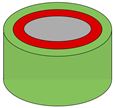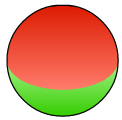Magnetization direction - How are the magnets magnetized?
The magnet shapes are only magnetized in the course of production, or rather, magnets are only created through magnetization.
The direction of magnetization then indicates where the poles of a magnet are or on which side of the magnet the north and south poles are:
- with discs, rods, rings often on the two circular surfaces,
- in blocks and cubes mostly on the large surfaces.
Magnets can be magnetized across any axis, allowing them to be used in different ways. The most common direction of magnetization is axial, but we also offer the diametral direction of magnetization in our range.
As examples:
- axially magnetized – loudspeakers, pot magnets, adhesive systems
- diametrically magnetized – motors, pumps
Here we have summarized the different magnet shapes for you:
Discmagnets
axial

Over 95% of our discmagnets are axially magnetized. i.e. the direction of magnetization runs parallel to the central axis and the magnetic poles lie on the two circular surfaces.
diametrically

Some of our discmagnets are also diametrically magnetized, which means that the magnet axis runs through the diameter, the poles on the magnet surfaces face each other.
bipolar

A special magnetization that is often used with memo magnets.
Rodmagnets
axial
 The most common magnetization is also with the rods through the height.
The most common magnetization is also with the rods through the height. diametrically

Our rodmagnets with diametrical magnetization.
Ringmagnets
axial
 Most of the rings are also axially magnetized.
Most of the rings are also axially magnetized.
diametrically
 We also have rings with diametrical magnetization in our range.
We also have rings with diametrical magnetization in our range. radial

Since the production is technically very difficult and expensive, there are hardly any manufacturers for this direction of magnetization. For this reason, we do not have these magnets in our range.
Blockmagnets
axial
 Normally, the blockmagnets are magnetized through the height (axially). Here the direction of magnetization is perpendicular to the opposite largest faces.
Normally, the blockmagnets are magnetized through the height (axially). Here the direction of magnetization is perpendicular to the opposite largest faces. diametrically
 Some blocks are longitudinally magnetized and have the magnetic poles on the two smaller faces.
Some blocks are longitudinally magnetized and have the magnetic poles on the two smaller faces. Cube magnets
 Like the cuboids, the cubes are magnetized by height and therefore lie on opposite sides.
Like the cuboids, the cubes are magnetized by height and therefore lie on opposite sides. Sphere magnets
 The magnetic poles of the spheres are opposite.
The magnetic poles of the spheres are opposite. Pot magnets

In the versions mentioned here, a raw magnet is glued into a steel pot. The deflection of the magnetic field increases the adhesive force in contrast to a normal raw magnet of the same dimensions. Since these magnets have south and north poles on the adhesive side, these types of magnets cannot be placed on top of each other with a perfect fit.
 Thousands of products in stock
Thousands of products in stock